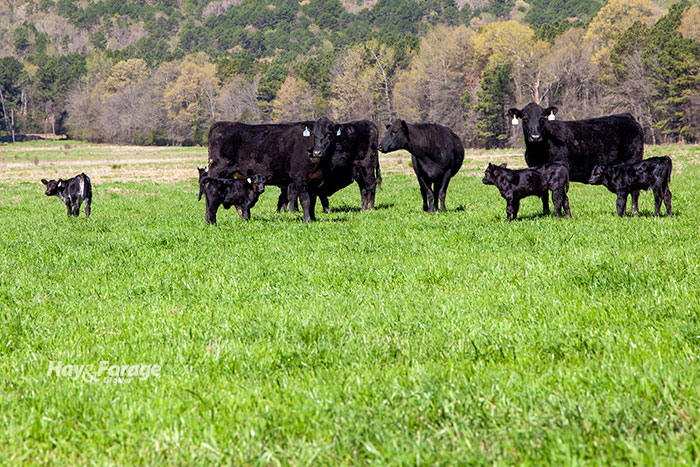From dry hay to lush grass |
| By Mike Rankin, Managing Editor |
|
|
 Making a livestock diet change is never easy, but perhaps no change is as drastic as moving from dry hay to lush, green forage in the early spring. Spring pasture management is both a blessing and a curse. On the one hand, there are usually ample acres of fast-growing forage; on the other, that extremely high-quality forage contains a lot of water, which sometimes makes it hard for cattle to consume enough dry matter to meet nutritional needs. Making an immediate switch from dry hay to the early spring growth can sometimes negatively affect livestock performance, according to information provided by the Kentucky Master Grazer Program. The highly digestible new growth has a lower fiber content than more mature growth and dry hay. Consuming this highly digestible feed can cause diarrhea, especially when livestock are quickly switched from a dry hay diet. It’s suggested to supplement a higher fiber feed such as dry hay as a portion of the diet, which can alleviate the problem by slowing rumen passage rates. When pastures are green but short, cattle have a more difficult time getting a full mouth of feed and expend energy moving around the pasture to consume adequate amounts of forage, reducing gains and body condition scores. This can also impact future reproductive efficiency. Mixing dry hay into the diet when shifting to early spring pastures allows animals to become accustomed to the change in diet, which can benefit herd health. As pastures continue to grow and cattle become accustomed to the fresh forage, hay can be gradually removed from the diet. Early spring is also a time when pastures must be set up for the upcoming grazing season. Many experts suggest that the forage height be at least 6 inches before opening the pasture gate, and then animals need to be moved when plants are grazed down to approximately 3 to 4 inches. With high amounts of precipitation in the spring, protect forages and soils from possible damage during wet conditions. Rotating livestock faster will minimize severe pugging and will keep more acres in a vegetative state for a longer period of time. Paddock moves and rotations need to occur much more quickly in the spring than during the summer. Supply minerals Mineral supplementation is needed for optimal animal health, growth, reproduction, and overall performance. This can be accomplished by feeding free-choice or adding minerals to a supplemented feed. Mineral nutrition should complement the forages and other feeds that the livestock are consuming. The location of free choice feeders can affect intake. Placing the feeder closer to a water source will enhance mineral intake. High salt concentration in a mineral mix will reduce intake. In the early spring, a high magnesium mineral is needed to reduce the risk of grass tetany. A “high-mag” mineral mix is usually fed until temperatures are consistently above 60°F. Twenty grams of magnesium per animal is required daily to effectively prevent grass tetany. Feed a free-choice mineral mix that contains 12% to 15% magnesium (from magnesium oxide). Cattle will need to consume about 4 ounces of the mineral mix per head to receive their daily requirement of magnesium.
|
